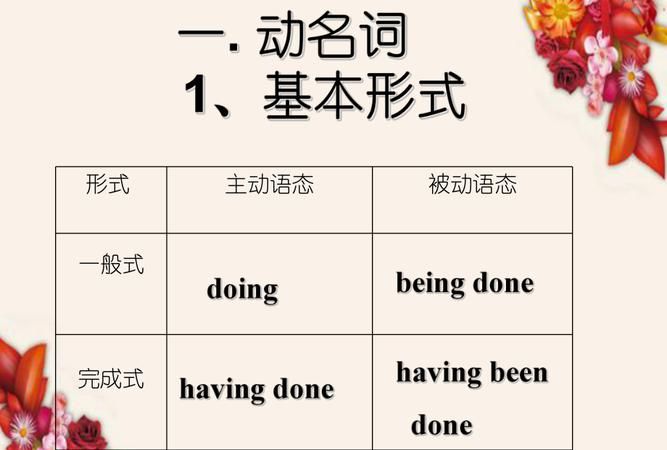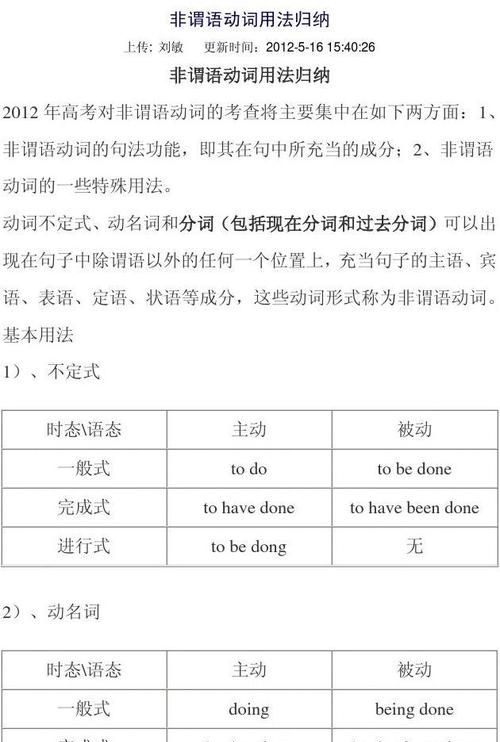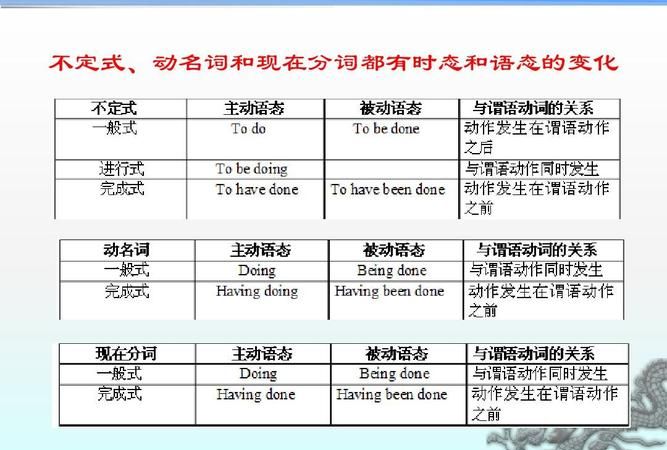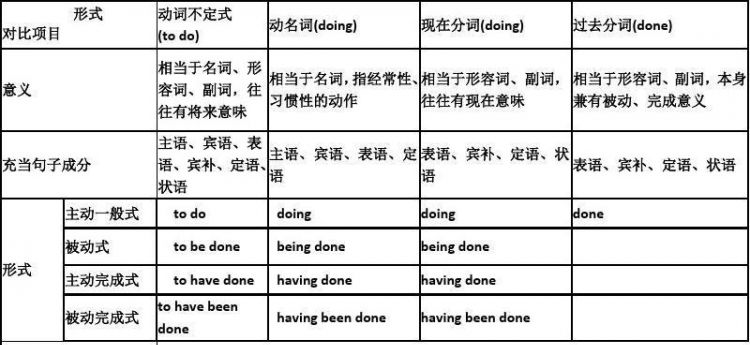本文目录
新概念第二册哪一课讲名词性从句
1.动名词定义:具有名词性质,可在句中担任主语,宾语表语,定语,具有所有格作修饰语。,2.形式:以do为例
doing → being done
having done → having been done,3.用法:,(1)主语:
Saving is easier than doing.
His ing here will be a great help.
It is no use waiting here, he has left.
There is no getting along with him.(简直无法和他相处),(2)表语:
His job is keeping the hall clean as possible.
Seeing is believing.,(3)宾语:
a. 动词宾语:
He admitted taking the book.
I do mind your *** oking here.
重磅要点: 下列动词须跟动名词作宾语:
admit, appreciate, avoid, plete, delay, deny, enjoy, fancy, finish, mind, practice, resent, risk, suggest, allow, permit...
特注:以allow为例:allow + doing sth(动名词作宾语)。但可以:Allow *** to do sth(不定式作宾补)。
这类动词常见如 advise, allow, permit, remend, etc.
b. 作介词宾语:
He left without saying goodbye to us.
I'm looking forward to meeting you.(to 在这里是介词),(4)定语:
reading room swimming pool walking stick,4.动名词复合结构:由名词所有格或物主代词与动名词构成。
His leaving is a great loss.
Mother dislikes my (me) working late.
John's having seen her did not make her worried.
注:动名词复合结构多作主语或宾语,作主语是必须是所有格。如上二例,但作宾语时可以用所有格,也可用普通格。,5.动名词时态:
I am thinking of setting a new dictionary.(以后)
He never talked to me about his having been in Paris.(以前),6.动名词语态:
He doesn't like being flattered.
I heard of his having been chosen to be the coach of the team.,7.动名词与不定式在用法上的几点比较:
(1)在 begin,start,continue 等词后用动名词或不定式区别不大。
He began writing / to write in 1980.
(2)下列动词跟不定式或动名词所表示意义差别很大,注意使用。
He stopped talking. 停止讲话。
He stopped to talk. 停下来开始讲话。
Please remember to post the letter. 记住寄走这封信。
I remember posting the letter. 我记得寄出了这封信。
I fot to lock the door yesterday. 昨天我忘记锁门了。(未锁)
I fot telling him the news. 我忘了我曾告诉过他这个消息。(做过的事情忘记了), 测试精编 ,workers favor ________ funds to build the bridge.
A. to raise B. raising C. raised D. rising,2. No one can avoid ________ by one's surroundings.
A. to be influenced B. having influenced
C. influencing D. being influenced,3. She doesn't feel like ________ tonight.
A. dancing B. to dance C. dance D. to be,4. Does Mr Wang object to ________ her the money?
A. that we lend B. be lent C. lending D. lend,5. I can still recall ________ with him many years ago.
A. to stay B. to staying C. to have stayed D. having stayed,(后设答案,大家不要偷看哦~(*^__^*) 嘻嘻……),KEYS,1. B 2. D 3. A 4. C 5. D

非谓语动词中动名词和现在分词有什么区别
动名词(gerund)和现在分词(present participle)的区别
所谓动名词(gerund)就是名词,只是保有一些动词的功能.所以它在句中可以作主语,宾语,表语,同位语,定语等那些名词可以充当的成分.
而现在分词(present participle)相当于形容词,在句中作定语或者状语
所以当-ing形式出现在句中作主语,宾语,同位语时,它肯定时gerund.
当-ing形式出现在句中作状语时,它肯定是present participle.
它们有可能被弄错的是作表语和定语时.其实也很好区分
1.作表语:我们知道,名词和形容词都可以作表语.
This is water(n.).
It is transparent(adj).
这时你肯定能明白,如果-ing作表语相当于n.它就是gerund.反之相当于adj.时它就是present.participle.
The situation both at home and abroad is very inspiring.
One of the best exercises is swimming.
2.作定语时的区别我在回答中已经解释了.动名词作定语时,表示它所修饰的名词的性能和用途,和它所修饰的名词在逻辑上没有主谓关系;现在分词作定语时,表示它所修饰的名词正在进行的动作,和它所修饰的名词在逻辑上有主谓关系.
a sleeping bag.(用途)=a bag for sleeping
a sleeping child = a child is sleeping (child是sleep的主语,sleep是child发出的动作)
(呵呵下面再请你告诉我它们分别是什么吧!
a swimming girl
a swimming pool
3.最后来解释修饰他们到底该用是adv,还是adj.
无论是Present participle.还是gerund,它们都叫做动词的-ing形式(所以若有人分不清它们时,多把它们混为一谈).也就是说它们都有动词的特点,故而都可用adv修饰.
eg:Reading a novel intently,I didn’t realize he came in.(reading,现分作状语,用adv intently修饰)
eg:My dream is speaking English perfectly.(speaking动名词,副词perfectly修饰.)
但gerund不仅有动词的特点,它也有名词的特点,这就决定了它也可以像名词一样用物主代词,形容词来修饰.
Would you mind my(物主代词) sitting here?
The mellow(愉快的,形容词) singing of the birds announces the coming of spring.

非谓语动词(不定式、动名词、分词)的构成及其用法
非谓语动词主要包括不定式、动名词和现在分词.为了区分这三种不同的非谓语动词的用法和含义,我们将分别从三种非谓语动词在句子中做主语、宾语、宾语补足语、定语、状语、表语以及一些特殊结构句型等角度来区分其用法和细微含义.
1.不定式和动名词作主语的区别
(1)动名词作主语通常表示抽象动作;而不定式作主语表示具体动作.
Smoking is prohibited(禁止)here.这里禁止抽烟.(抽象)
It is not very good for you to smoke so much.你抽这么多烟对你身体很不好.(具体)
(2)动名词作主语时,通常用以表示一件已知的事或经验.
不定式短语通常用来表示一件未完成的事或目的.
Climbing mountains is interesting.爬山很有趣.(经验)
Driving a car during the rush hour is tiring.在高峰时刻开车令人厌烦.(经验)
(3)不定式做主语,一般用it当形式主语,把作主语的不定式短语后置.
It took me only five minutes to finish the job.
2.不定式、动名词和分词作表语的区别
(1)不定式作表语
1)不定式作表语一般表示具体动作,特别是表示将来的动作.
To do two things at a time is to do neither.一次做两件事等于未做.
What I would suggest is to start work at once.我的建议是立刻开始干.
2)如果主语是不定式(表示条件),表语也是不定式(表示结果).
To see is to believe.百闻不如一见.
To work means to earn a living.工作就是为了生活.
3)如果主语是以aim, duty, hope, idea, happiness, job, plan, problem, purpose, thing, wish等为中心的名词,或以what引导的名词性从句,不定式作表语是对主语起补充说明作用.
His wish is to buy a luxurious car in the near future.他的希望是在不远的将来买一辆豪华轿车.
The function of Louis Sullivan’s architecture was to provide large uninterrupted floor areas and to allow ample light into the interior.
The most important thing is to negotiate with them about the future of the plant.
(2)动名词作表语:动名词作表语,表示抽象的一般性的行为.
Our work is serving the people.我们的工作是为人民服务.
His hobby is collecting stamps.他的爱好是集邮.
(注)动名词作表语时与进行时态中的现在分词形式相同,但其所属结构迥异,进行时态说明动作是由主语完成的.动名词做表语,说明主语的性质或情况.
People cannot but feel puzzled, for they simply cannot understand how he could have made such a stupid mistake.
His victory in the final was no more convincing than I had expected.
(3)分词作表语
分词做表语有两种情况,一种是现在分词做表语,一种是过去分词做表语,这两者区别是考试中经常考到的地方.一般来说,表示心理状态的动词如excite, interest等都是及物动词,汉语意思不是“激动”,“高兴”,而是“使激动”、“使高兴”,因而现在分词应该是“令人激动的”、“令人高兴的”,过去分词则是“感到激动的”和“感到高兴的”.所以,凡表示“令人……的”都是-ing形式,凡是表示“感到……”都用-ed形式.换句话说,若人对……感兴趣,就是somebody is interested in...,若人/物本身有兴趣时,就是说sb./sth. is interesting.这类词常见的有:
interesting使人感到高兴--interested感到高兴的
exciting令人激动的--excited感到激动的
delighting令人高兴的--delighted感到高兴的
disappointing令人失望的--disappointed感到失望的
encouraging令人鼓舞的--encouraged感到鼓舞的
pleasing令人愉快的--pleased感到愉快的
puzzling令人费解的--puzzled感到费解的
satisfying令人满意的---satisfied感到满意的
surprising令人惊异的--surprised感到惊异的
worrying令人担心的--worried感到担心的
Travelling is interesting but tiring.旅行是有趣的,但是使人疲劳.
The pupils will get confused if they are made to learn too much.如果要学生学得太多,他们会感到糊涂的.
The argument is very convincing.他的论点很令人信服.
They were very excited at the news.听到这个消息,他们非常激动

非谓语动词怎么判断用不定式还是动名词
非谓语动词包括不定式,动名词和分词。
其中有些动词既可以用不定式,也可以用动名词作宾语,并且意义差别不大。
一般来说:动名词作宾语更强调一般,不定式更强调具体。例如:
I
like
reading
novels
but
I
don't
like
to
read
this
novel.
有些动词(常见的有remember,forget,regret)接动名词表示已经做过的事,不定式表示要做的事。如:
regret
to
do(为将要做的事感到不安) regret
doing(为做过某事而感动后悔)
有的动词(实义动词need/want)接动名词表示被动,如
want
to
do(想做某事)
need
reparing(需要被修理)
另外:
go
on
to
do (做完了一件事)接着做另一件事
go
on
doing 继续做某事
try
to
do设法做某事
try
doing试着做某事

以上就是关于非谓语动词中的动名词,新概念第二册哪一课讲名词性从句的全部内容,以及非谓语动词中的动名词 的相关内容,希望能够帮到您。

